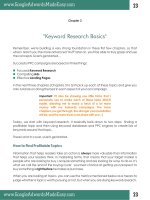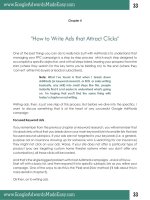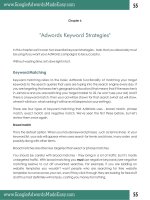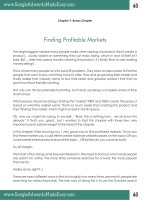Tài liệu Google Adwords-Chapter 6 "Adwords Keyword Strategies" pptx
Bạn đang xem bản rút gọn của tài liệu. Xem và tải ngay bản đầy đủ của tài liệu tại đây (182.3 KB, 8 trang )
55
55
Chapter 6
In this chapter we'll cover two essential keyword strategies - tools that you absolutely must
be using if you want your AdWords campaigns to be successful.
Without wasting time, let's dive right into it.
Keyword matching refers to the basic AdWords functionality of matching your target
keywords to the search queries that users are typing into the search engine every day. If
you are targeting that searcher's geographical location (that means that if the searcher is
in Jamaica and you are restricting your target market to US, he won't see your ad) and if
there is a keyword match, then your ad will be shown for that search (what ad will show,
where it will show, what ranking it will have will depend on your settings).
There are four types of keyword matching that AdWords uses - broad match, phrase
match, exact match and negative match. We've seen the first three before, but let's
review them once again.
This is the default option. When you include keyword phrases such as tennis shoes in your
keyword list, your ads will appear when users search for tennis and shoes, in any order and
possibly along with other terms.
Broad matches are often less targeted than exact or phrase matches.
You should be careful with broad matches - they bring in a lot of traffic but it's mostly
untargeted traffic. With broad matching you use negative keywords (see negative
matching below) to cut off unwanted searches. For example, if you are bidding on
website templates you wouldn't want people who are searching for free website
templates to come across your ad - even if they click through they are looking for free stuff
and thus most definitely will not pay, costing you money for nothing.
Broad match
must
"Adwords Keyword Strategies"
Keyword Matching
www.GoogleAdwordsMadeEasy.com
www.GoogleAdwordsMadeEasy.com
56
56
Example:
Your ad appears when users search on the exact phrase and also when their search
contains additional terms, as long as the keyword phrase is in exactly the same order. A
phrase match for "tennis shoes" would include "red tennis shoes" but not "shoes for tennis."
Phrase matches are useful when you want to target exact word combinations, such as
"bose speakers" or "california DUI lawyer".
Example:
Phrase match
www.GoogleAdwordsMadeEasy.com
www.GoogleAdwordsMadeEasy.com
57
57
Exact match
Negative match
The search query must exactly match your keyword. This means "tennis shoes" will only
match a user request for "tennis shoes" and not for "red tennis shoes," even though the
second query contains your keyword.
Exact matches are the most specific type of keyword matching - your ad shows only if
your keywords exactly match the search.
This cuts down on the number of potential searches you can target, so it's always a good
idea to use phrase matching and some broad matching as well.
Example:
When you don't want your ad to show for certain keywords, you can put that keyword
here. One of the most common negative matches is 'free'. In your keyword research you
may also come across a lot of terms that you don't want to target. By entering them as
negative matches, you will be able to cut down on wasteful clicks.
Be careful of what you put in as negative keywords though - you might end up cutting
off some very valuable keyword searches.
Broad match: keyword as it is
Phrase match: "keyword in quotes"
Exact match: [keyword in brackets]
Negative match: -keyword with trailing minus sign
www.GoogleAdwordsMadeEasy.com
www.GoogleAdwordsMadeEasy.com
58
58
For more help on keyword matching, watch this Flash tutorial the AdWords help site on
.
Example:
moving on...
As you've learned thus far, one of the most important aspects of profitting with Google
Adwords is writing an ad that is specifically targeted to what the visitor is looking for.
If everything was perfect, and we had an infinite amount of time, we would write an
individual ad for each and every keyword. But, guess what? Everything isn't perfect, and
we most definitely have a finite amount of time each day.
You should start off with a small number of ad groups (If you don't remember what a group
is, please refer to a previous chapter.) Starting with a small number of ad groups will make
things much easier for you to manage AND monitor in the beginning. Monitoring the
performance of your keywords is HUGE when you first create an ad via Adwords.
Alright, now in your ad group you should write 2 good ads, 1 slightly different than the
other for split testing purposes, and then place several "related" keywords into the group.
At this point, don't worry if the ad that you wrote matches EXACTLY with each keyword. It's
not possible at this time, because you're placing related keywords into this 1 group to get
a good feel for which words will bring you the most traffic.
So, what do we do?
keyword matching
Peel and Stick
www.GoogleAdwordsMadeEasy.com
www.GoogleAdwordsMadeEasy.com
59
59
After some time goes by, you'll notice that some keywords are bringing more traffic to
your website that you would have expected. (i.e. getting you more clicks than you would
have initially thought).
This is where the "Peel and Stick" method comes in so very handy. These keywords that you
notice are getting you more clicks, you'll want to "peel" them and "stick" them into their
own ad group.
Simple... Because if you can write an ad that is specifically written for each of these high
performaing keywords, you WILL increase your clickthrough rate (the number of people
that click on the ad). Increasing the clickthrough rate will do 2 things:
2. Lower the price you're currently paying for each visitor. Remember, Google
rewards good advertisers, by lowering the price you'll pay per click, the higher you can
get your clickthrough rate. So, obviously, the goal is to get as high of a clickthrough rate as
possible.
So, what we've essentially done here is:
2. "Peeled" those keywords from the "generic" ad group we started with.
4. Wrote a killer ad, specifically taylored around these keywords
After doing this, what should happen is...
2. You'll get more visitors to your website
4. You'll pay less per visitor because of the increased clickthrough rate
Why?
1. Get more visitors to your website to see your sales message
1. Found a few keywords that are sending us a good amount of traffic, but don't have
as high of a clickthrough rate as they could.
3. "Stuck" those keywords into their own ad group
1. You'll increase your clickthrough rate
3. You'll presell your visitor better BEFORE they get to your website, just by viewing your
targeted ad
5. You'll increase your Adwords ranking
www.GoogleAdwordsMadeEasy.com
www.GoogleAdwordsMadeEasy.com









